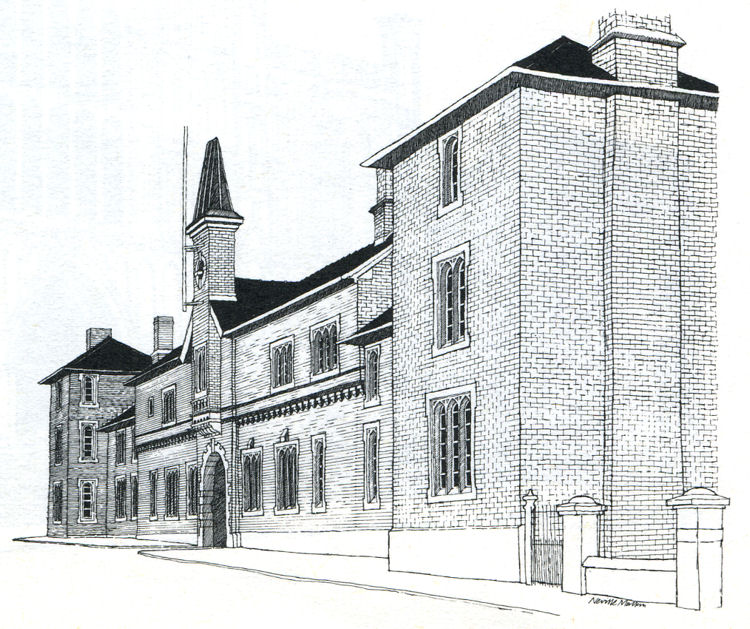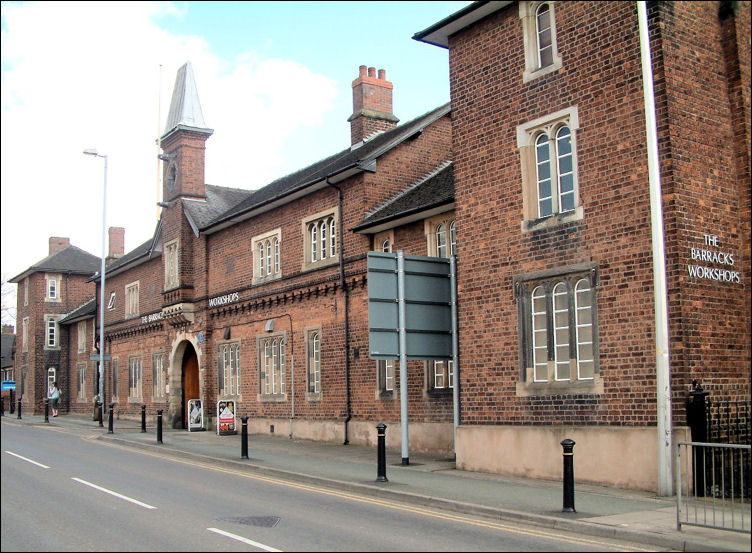|
|
|
![]() back to "The Grand Tour" index
back to "The Grand Tour" index
Neville Malkin's "Grand Tour" of the Potteries
buildings in and around Newcastle-under-Lyme
![]()
![]()
![]()
next: The Guildhall,
Newcastle
previous: Holy Trinity
Church, Newcastle
contents: index of buildings in and around Newcastle-under-Lyme
|
No 22 - The Barracks, Newcastle
|

The Barracks,
Newcastle
pen drawing by Neville Malkin - June 1975

The Barracks,
Barracks Road,
Newcastle - April 2009
|
"This building could quite easily be mistaken for some fortress in an early movie or even the prototype for a kiddies' fort, but, in fact, it is the Italian-style Barracks in Newcastle, built in 1855. The stern-looking brick exterior of this garrison encloses a large drill square approached through a castellated tower. It was originally the headquarters of the local militia, a force of local volunteers who could be called out in emergencies. Such local militia wore uniforms that looked remarkably like those worn by the US Cavalry of cinema repute; such volunteers were common throughout England until 1907, when they were superseded by the Territorial Army. The King's Own Staffordshire Rifle Regiment, who had muzzle-loading guns, occupied this building until 1880 when they were followed by a succession of volunteer forces. Now the premises provide useful accommodation for Remploy Ltd. This building was also the HQ for the fire brigade until the 1890s, when they moved into purpose-built premises. Newcastle's concern for fire and its consequences was clearly demonstrated in 1623 when leading citizens were required to possess a leather bucket for the purpose of combating outbreaks of fire. The mid-17th century saw the introduction of fire-lookers and a few years later fines of £2 were imposed on those who failed to keep their chimneys in good order. But it was not until about 1740 that the town acquired its first manual fire engine; not until 1819 was the use of thatch on buildings forbidden. In the 1840s, the superintendent of police, who was then in charge of the fire service, had two fire-engines and 20 or more firemen under his control. More modern appliances were gradually introduced during the mid-19th century; finally, in 1888, a volunteer fire brigade was formed that detached itself from police administration." Neville Malkin 18th June 1975
|
|
|
next: The Guildhall, Newcastle
previous: Holy Trinity Church, Newcastle
contents: index of buildings in and around Newcastle-under-Lyme
back to "The Grand Tour" index